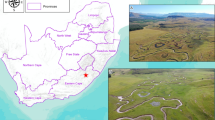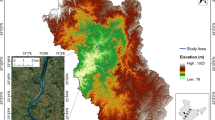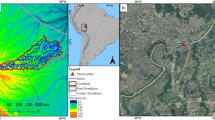Abstract
Topography has been traditionally used as a surrogate to model spatial patterns of water distribution and variation of hydrological conditions. In this study, we investigated the use of light detection and ranging (lidar) data to derive two Single Flow Direction (SFD) and five Multiple Flow Direction (MFD) algorithms in the application of the compound topographic index (CTI) for mapping wetlands. The CTI is defined here as ln [(α)/(tan (β)], where α represents the local upslope contributing area and β represents the local slope gradient. We evaluated the following flow direction algorithms: D8, Rho8, DEMON, D-∞ MD-∞, Mass Flux, and FD8 in three ecoregions in Minnesota. Numerous studies have found that MFD algorithms better represent the spatial distribution of water compared to SFD algorithms. CTI maps were compared to field collected and image interpreted reference data using traditional remote sensing accuracy estimators. Overall accuracy results for the majority of CTI based algorithms were in the range of 81–92 %, with low errors of wetland omission. The results of this study provide evidence that 1) wetlands can be accurately identified using a lidar derived CTI, and 2) MFD algorithms should be preferred over SFD algorithms in most cases for mapping wetlands.







Similar content being viewed by others
References
Anteau MJ, Afton AD (2009) Wetland use and feeding by lesser scaup during spring migration across the upper Midwest, USA. Wetlands 29:704–712
Antonarakis AS, Richards KS, Brasington J (2008) Object-based land cover classification using airborne Lidar. Remote Sensing of Environment 112:2988–2998
Beven KJ, Kirkby MJ (1979) A physically based, variable contributing area model of basin hydrology. Hydrological Sciences Journal 24:43–69
Bridgham SD, Pastor J, Dewey B, Weltzin JF, Updegraff K (2008) Rapid carbon response of peatlands to climate change. Ecology 89:3041–3048
Burrough PA, McDonell RA (1998) Principles of geographical information systems. Oxford University Press, New York, 190 pp
Chaplot V, Walter C (2003) Subsurface topography to enhance the prediction of the spatial distribution of soil wetness. Hydrological Processes 17:2567–2580
Charman DJ (2009) Peat and peatlands. Elsevier Inc, 541–548
City of Chanhassen Surface Water Management Plan (2006) In: The second generation surface water management plan - Chanhassen, Minnesota: http://www.ci.chanhassen.mn.us/serv/cip/swmp/wetlandsmanagement.htm. Accessed 25 May 2013
Congalton RG, Green K (2009) Assessing the accuracy of remotely sensed data: principles and practices, 2nd edn. CRC Press/Taylor and Francis, Boca Raton
Corcoran JM, Knight JF, Brisco B, Kaya S, Cull A, Murnaghan K (2011) The integration of optical, topographic, and radar data for wetland mapping in northern Minnesota. Canadian Journal of Remote Sensing 37(5):564–582
Costa-Cabral M, Burges SJ (1994) Digital elevation model networks (DEMON): a model of flow over hillslopes for computation of contributing and dispersal areas. Water Resources Research 30:1681–1692
Cowardin, L.M., V. Carter, F.C. Golet, and E.T. LaRoe, 1974. Classification of wetlands and deepwater habitats of the United States, U.S. Department of the Interior, Fish and Wildlife Service, Washington, D.C.
Dahl TE (2006) Status and trends of wetlands in the conterminous United States 1998 to 2004. U.S. Department of the Interior; Fish and Wildlife Service, Washington, D.C., p 112
Dahl TE, Johnson CE (1991) Status and trends of wetlands in the conterminous United States, mid-1970’s to mid-1980’s. U.S. Fish and Wildlife Service, Washington, DC, p 28
Erskine RH, Green TR, Ramirez JA, MacDonald LH (2006) Comparison of grid-based algorithms for computing upslope contributing area. Water Resources Research 42, W09416
Fairfield J, Leymarie P (1991) Drainage networks from grid digital elevation models. Water Resources Research 27:709–717
Freeman GT (1991) Calculating catchment area with divergent flow based on a regular grid. Computers and Geosciences 17:413–422
Grabs T, Seibert J, Bishop K, Laudon H (2009) Modeling spatial patterns of saturated areas: a comparison of the topographic wetness index and a dynamic distributed model. Journal of Hydrology 373:15–23
Gruber S, Peckham S (2008) Land-surface parameters and objects in hydrology. In: Hengl T, Reuter HI (eds) Geomorphometry: concepts, software, applications. Elsevier, Amsterdam, pp 171–194
Guntner A, Seibert J, Uhlenbrook S (2004) Modeling spatial patterns of saturated areas: an evaluation of different terrain indices. Water Resources Research 40, W05114
Jenkins RB, Frazier PS (2010) High-resolution remote sensing of upland swamp boundaries and vegetation for baseline mapping and monitoring. Wetlands 30:531–540
Knight JF, Tolcser BT, Corcoran JM, Rampi LP (2013) The effects of data selection and thematic detail on the accuracy of high spatial resolution wetland classifications. Photogrammetric Engineering and Remote Sensing 79:613–623
LaBaugh JW, Winter TC, Rosenberry DO (1998) Hydrologic functions of prairie wetlands. Great Plains Research: A Journal of Natural and Social Sciences 8:17–37
Land Management Information Center (LMIC) (2007) Metadata for the National Wetlands Inventory, Minnesota
Lang MW, McCarty GW (2009) Lidar intensity for improved detection of inundation below the forest canopy. Wetlands 29:1166–1178
Lang MW, McCarty GW, Oesterling R, Yeo I (2013) Topographic metrics for improved mapping of forested wetlands. Wetlands 33:141–155
Minnesota Department of Administration (AdminMN) Office of geographic and demographic analysis state demographic center, 2010 census: Minnesota city profiles. http://www.demography.state.mn.us/CityProfiles2010/index.html. Accessed 20 May 2013
Moore ID, Gessler PE, Nielsen GA, Peterson GA (1993) Soil attribute prediction using terrain analysis. Soil Science Society of America Journal 57:443–452
O’Callaghan JF, Mark DM (1984) The extraction of drainage networks from digital elevation data. Computer Vision, Graphic and Image Processing 28:328–344
Pan F, Peters- Lidar CD, Sale MJ, King AW (2004) A comparison of geographical information system-based algorithms for computing the TOPMODEL topographic index. Water Resources Research 40:1–11
Prince H (2008) Wetlands of the American Midwest: a historical geography of changing attitudes. Chicago: University of Chicago Press
Rodhe A, Seibert J (1999) Wetland occurrence in relation to topography - a test of topographic indices as moisture indicators. Agricultural and Forest Meteorology 98–99:325–340
Seibert J, McGlynn B (2007) A new triangular multiple flow direction algorithm for computing upslope areas from gridded digital elevation models. Water Resources Research 43:1–8
Shoutis L, Dunca TP, McGlyn B (2010) Terrain-based predictive modeling of Riparian vegetation in Northern Rocky Mountain watershed. Wetlands 30:621–633
Sørensen R, Seibert J (2007) Effects of DEM resolution on the calculation of topographical indices: TWI and its components. Journal of Hydrology 347:79–89
Sørensen R, Zinko U, Seibert J (2006) On the calculation of the topographic wetness index: evaluation of different methods based on field observations. Hydrology and Earth System Sciences 10:101–112
Stedman S, Dahl TE (2008) Status and trends of wetlands in the coastal watersheds of the Eastern United States 1998 o 2004. National Oceanic and Atmospheric Administration, National Marine Fisheries Service and U.S. Department of the Interior, Fish and Wildlife Service, 32 pages
Tarboton DG (1997) A new method for the determination of flow directions and upslope areas in grid digital elevation models. Water Resources Research 33:309–319
Wilson JP, Gallant JC (2000) Secondary topographic attributes. In: Wilson JP, Gallant JC (eds) Terrain analysis: principles and applications. Wiley, New York, pp 87–131
Wilson JP, Aggett G, Deng YX, Lam CS (2008) Water in the landscape: a review of contemporary flow routing algorithms. In: Zhou Q, Lees B, Tang G (eds) Advances in digital terrain analysis. Springer, Berlin, pp 213–236
Winter TC, Rosenberry DO (1995) The interaction of ground water with prairie pothole wetlands in the Cottonwood Lake Area, eastcentral North Dakota, 1979–1990. Wetlands 15:193–211
Zhou Q, Liu X (2002) Error assessment of grid-based flow routing algorithms used in hydrological models. International Journal of Geographical Information Science 16:819–842
Acknowledgments
This research was funded by the Minnesota Environment and Natural Resources Trust (ENRTF), the Minnesota Department of Natural Resources (MNDNR), and the United States Fish and Wildlife Services (USFWS: Award 30181AJ194).
Author information
Authors and Affiliations
Corresponding author
Rights and permissions
About this article
Cite this article
Rampi, L.P., Knight, J.F. & Lenhart, C.F. Comparison of Flow Direction Algorithms in the Application of the CTI for Mapping Wetlands in Minnesota. Wetlands 34, 513–525 (2014). https://doi.org/10.1007/s13157-014-0517-2
Received:
Accepted:
Published:
Issue Date:
DOI: https://doi.org/10.1007/s13157-014-0517-2




